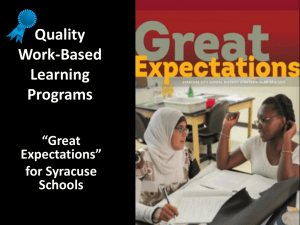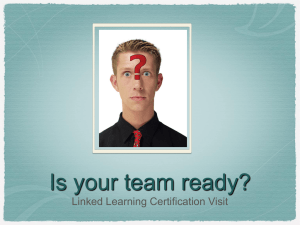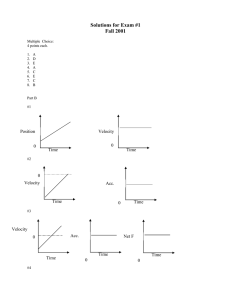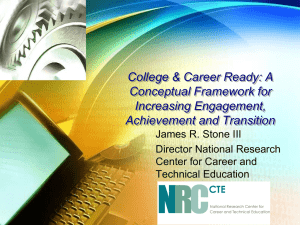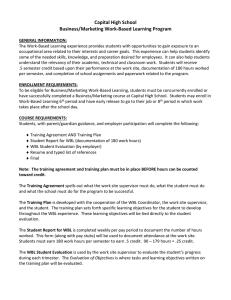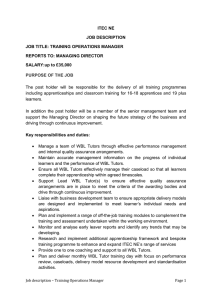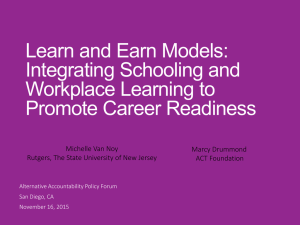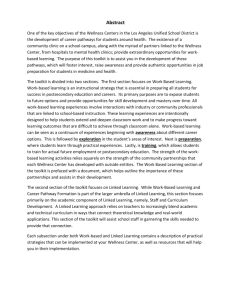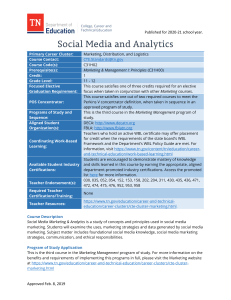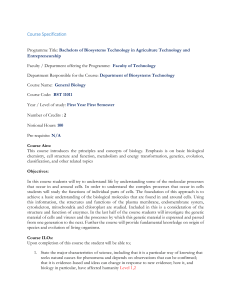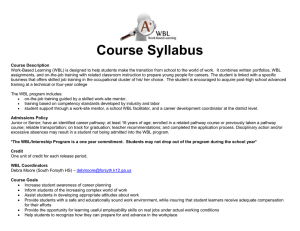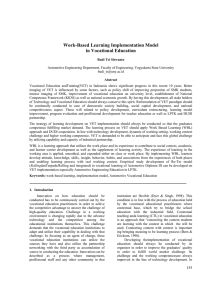Work-Based Learning (WBL) in College & Career Pathways David Stern
advertisement
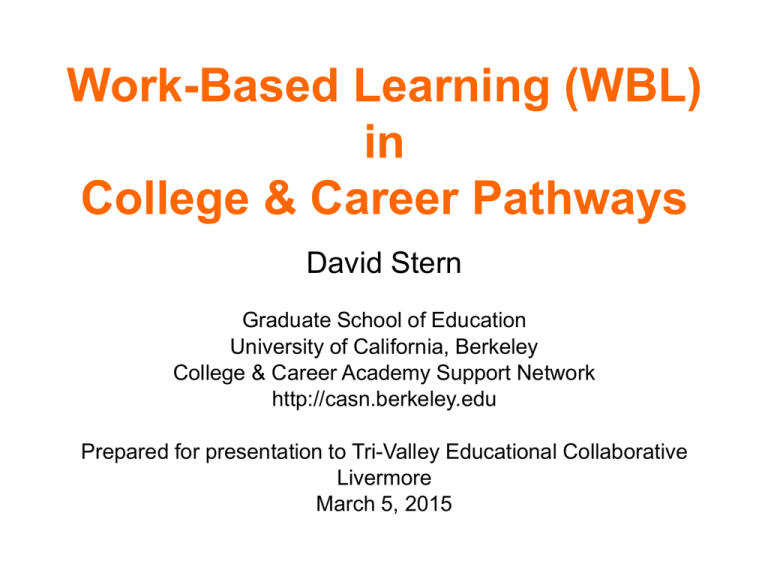
Work-Based Learning (WBL) in College & Career Pathways David Stern Graduate School of Education University of California, Berkeley College & Career Academy Support Network http://casn.berkeley.edu Prepared for presentation to Tri-Valley Educational Collaborative Livermore March 5, 2015 Overview WBL as an element of C&C pathways Practice for high school students Forms of WBL WBL in C&C Pathways Expand options for students: combine college and career preparation! WBL is integrated into a multi-year sequence of college-prep and CTE courses. Students receive personal support. Cohort scheduling helps with integrating curriculum and with student support. Pathways that combine these features have been found to improve high school students’ preparation for both • employment and • postsecondary education Eight years after high school, MDRC found students assigned to career academies earned 11 percent more than nonacademy students. For males, the difference was 17 percent –– nearly $30,000 over eight years. California Partnership Academy graduates exceed state average a-g completion rate Summary of research on career academies available at http://casn.berkele y.edu WBL: practice, practice! How does anyone get good at baseball, playing piano, or being a truck driver, teacher, or phlebotomist? Before industrialization and urbanization, children learned to work by working alongside adults. What should high school students practice? 1 Specific job skills and procedures 2 And, for long-term career success, various social and emotional capabilities What are social and emotional capabilities? Longitudinal studies that have measured certain things like self-esteem, locus of control, and planfulness in young people have found these predict career success several decades later. These correlations are independent of years of schooling and measures of cognitive achievement. More opinions than evidence Longitudinal studies don’t give us a complete list, or tell us which are most important. Various lists have been proposed: SCANS (1991), soft skills (Levy and Murnane, 1996), 21st century skills, scout virtues…. But no one can say which of these will be most important in workplaces several decades from now. What high schools should do… Do: Engage students in learning through work where they take responsibility for meeting demands of real clients or customers. Evaluate students’ performance by standards of adult professional work. • Do: Ensure that students’ work affords opportunity to develop various social and emotional capabilities such as collaboration with coworkers of different ages, communication with clients and customers, taking initiative, confronting unanticipated problems, setting priorities, etc. Include successful performance in WBL as a metric in LCAPs! …and not do Don’t: Rely on “career readiness” tests that have not been shown to predict actual success at work. Summary of research on WBL (Darche and Stern) available at http://casn.berkeley .edu Forms of WBL Learning through work: school-based enterprise, e.g. construction, retail, apps, media, food, manufacturing, studies for civic clients, etc. internships, paid or unpaid Work-Based Learning Continuum Career Awareness Learning ABOUT work. Build awareness of the variety of careers available and the role of post-secondary education; Broaden student options. Career Exploration Learning ABOUT work. Career Preparation: Practicum & Internships Explore career options and postsecondary requirements for purpose Learning THROUGH work. Sample Student Learning Outcome: of motivation and to inform Apply learning through practical decision-making in high school and experience that develops knowledge and Student can articulate the type of post-secondary. skills necessary for success in careers post-secondary education and and post-secondary education. training required in the career field Sample Student Learning Outcome Sample Student Learning Outcome and its importance to success in that Student can give at least two Student builds effective collaborative field. examples of how the student’s working relationships with colleagues individual skills and interests relate Experience Defined by: and customers; is able to work with to the career field and/or diverse teams, contributing •One-time interaction with occupations. appropriately to the team effort; partner(s), often for a group of Experience Defined By: students An Experience Differentiated By: •Designed primarily by adults to broaden student’s awareness of a wide variety of careers and occupations Experiences might include: • Workplace tour • Guest speaker • Career fair • Visit parents at work •One-time interaction with partner(s) for a single student or small group •Personalized to connect to emerging student interests. •Student takes an active role in selecting and shaping the experience •Depth in particular career fields. •Builds skills necessary for in-depth work-based learning Experiences might include: •Informational interview •Job shadow •Virtual exchange with a partner •Direct interaction with partners over time •Application of skills transferable to a variety of careers •Activities have consequences and value beyond success in the classroom. •Learning for student and benefit to partner are equally valued Experiences might include: •Integrated project with multiple interactions with professionals •Student-run enterprise with partner involvement •Virtual enterprise or other extended online interactions with partners •Projects with partners through industry student organizations •Service learning and social enterprises with partners •Compensated internship connected to curriculum Career Training Learning FOR work. Train for employment and/or post-secondary education in a specific range of occupations. Sample Student Learning Outcome Student demonstrates knowledge and skills specific to employment in a range of occupations in a career field. An Experience Differentiated By: •Interaction with partners over extended period of time. •Benefit to the partner is primary and learning for student is secondary. •Develop mastery of occupation specific skills. •Complete certifications or other requirements of a specific range of occupations. Experiences might include: •Internship required for credential or entry to occupation •Apprenticeship •Clinical experience •On-the-job training •Work experience
